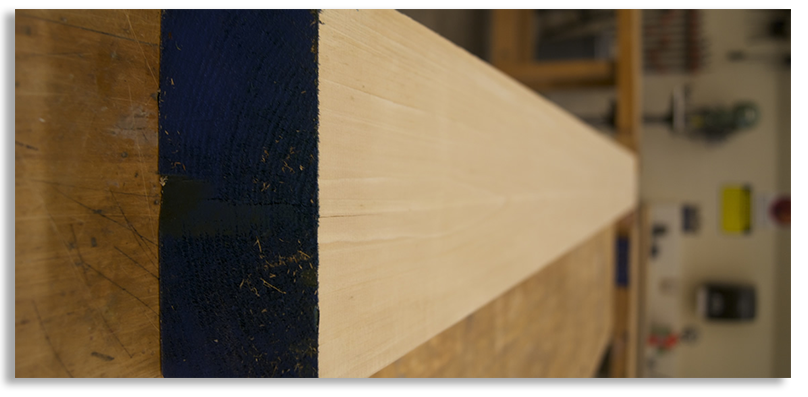The Fab Lab
I collaborated with Paul Walde and the Department of Visual Arts during the mid-2010s to establish a Digital Fabrication Lab (DFL) at UVic with support from the Canada Foundation for Innovation and the British Columbia Knowledge Development Fund. Paul and I were successful with a launch in 2015, and the DFL’s been operating in UVic’s Visual Arts Building since then.
Researchers in the MLab often used the DFL to manufacture 3D models and prototypes in (usually discarded or scrap) materials such as wood, paper, cardboard, and foam. The DFL’s now used by a broader group of students, staff, and faculty members.
Below is an excerpt of a 2015 UVic news article, where John Threlfall and the Faculty of Fine Arts officially announce the Digital Fabrication Lab. I also point to the DFL’s website, the MLab’s inventory, related MLab posts and research (including a 2014 environmental scan of digital fabrication sites on U.S. and Canadian university campuses), and a talk I gave in 2015 at the BC Library Conference on the DFL’s infrastructure. Thanks to Paul, John, Cliff Haman, Hollis Roberts, Margaret Cameron, and everyone across Fine Arts and the Humanities at UVic who helped to make the DFL happen.

Digital Fabrication Lab (DFL)
May 2015 - Present | Arts + Humanities Lab | UVic Visual Arts Building
Links: lab website (HTML); The Humanities Lab as a Makerspace (HTML); An Infrastructural Disposition (HTML); MLab research on digital fabrication (HTML); makerspace and fab lab inventory (CSV); environmental scan of digital fabrication sites on U.S. and Canadian university campuses (CSV); talk with slides at the BC Library Conference (HTML)
Supported by the Canada Foundation for Innovation, Social Sciences and Humanities Research Council of Canada, British Columbia Knowledge Development Fund, and UVic’s Faculty of Humanities, Faculty of Fine Arts, Department of English, and Department of Visual Arts
“UVic’s Digital Fabrication Lab the first of its kind in North America,” by John Threlfall on 13 July 2015 | excerpt | read the original
UVic is once again leading the pack with the creation of the Digital Fabrication Lab (DFL). A collaboration between the Department of Visual Arts and the preexisting Maker Lab in UVic’s Electronic Textual Cultures Lab, the DFL is the first of its kind to encompass the arts and humanities in North America. Additionally, no university or college in North America yet has a computer numerical control (CNC) lab in the humanities, meaning the DFL is the first humanities facility of its kind on the continent.
“There are far-reaching effects for this type of technology in just about everything we do,” says Department of Visual Arts chair Paul Walde. “Photography was the first area where there was almost a complete paradigm shift towards digital, and we’re now seeing digital technology move into every aspect of visual arts production. This represents a way for us to move forward not only with new sculptural techniques and projects but also printmaking and even certain kinds of painting.”
The DFL will include CNC routers, an industrial grade 3D scanner, a laser cutter, a milling machine, and 3D printers, together with various machining tools. “Visual Arts is a leader in material practices and material culture,” says Walde, who notes they already have extensive workshops and the necessary support staff to expand into this area. “We have purpose-built facilities for the safe handling and research of these applications. It’s a perfect fit for us . . . it’s an investment in the future.”
The Maker Lab at UVic, housed in the Technology Enterprise Facility, is a collaborative space of new techniques and old technologies involving the invention of imaginative and often outsized revisions of objects that don’t always exist in the world. Because its research is innovative, multi-faceted and occasionally intangible, it does not easily fit a simple definition.
The lab is inspired by experimental art, design and D.I.Y. cultures. The inter-disciplinary research team from UVic English, CSPT and Visual Arts includes faculty as well as undergraduate and graduate students who use physical computing and digital fabrication for cultural research.
The lab was launched in September 2012, under the leadership of director Dr. Jentery Sayers, an assistant professor, English and CSPT, with funding from the Social Sciences and Humanities Research Council, Canada Foundation for Innovation and the British Columbia Knowledge Development Fund.
Sayers describes the Maker Lab as an “intersection of cultural criticism and comparative media studies with computation, prototyping, electronics and experimental methods. Its design is anchored in blending a humanities research lab with a makerspace–a design that affords its team of students and faculty opportunities to build projects through various modes of ‘knowing by doing,’ such as programming, markup, new media production, data modeling, 3D printing and circuit design.”
The lab’s research will ultimately “inform policies on the ethics, distribution, licensing and derivation of 3D objects,” says Sayers, policies which currently do not exist in Canada. The lab also trains students in physical computing and desktop fabrication in non-STEM fields. Sayers points out that fabrication and physical computing are popular in STEM fields, but are virtually unknown in the humanities. . . .
“I’m very excited about it,” says Walde about the DFL and this new Visual Arts collaboration with Humanities. “I can’t wait to see what the possibilities are with this equipment. That’s usually what gets the imagination stirring.”
Featured image and photograph from work done in the Visual Arts Building care of Nicole Clouston. Both used with permission. I created this page on 25 July 2019 and last updated it on 30 January 2022.